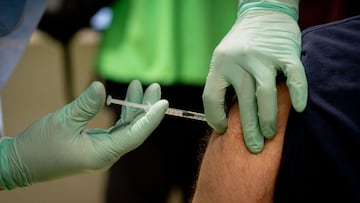Coronavirus US: how long will there be restrictions according to the experts?
Does the covid-19 vaccine mean herd immunity? Do the new strains pose a risk to return to normality? When can you finally throw away the mask?

It’s been nearly a year now since America was thrown into the grips of the coronavirus pandemic. Fatigue with public health measures, especially mask wearing and lockdowns set in long ago. More infectious strains have been detected separately in the UK and South Africa, and both have now unpacked their bags in the US, which brings yet more uncertainty. So what does all of it mean for our semblance of normal life, when can we be without masks and lockdowns?
According to an insights report provided by McKinsey & Company, their earliest estimate for herd immunity is towards the end of 2021, but several factors could slow this down, and even then when immunity is achieved, that doesn’t necessarily mean that the masks are off forever.
Their report summarises that we may be heading toward normality in the US in the second quarter of 2021 – April onwards - and herd immunity in the third and fourth quarters – between July and December - but the emergence of new strains and a slow start to vaccine rollout pose real risks to the pace of both timelines.
Vaccine plus sunshine equals herd immunity?
Herd immunity is achieved when a sufficient portion of a population is simultaneously immune to a disease, preventing sustained transmission.
While the US could still achieve herd immunity in the third or fourth quarter of 2021, the emergence of more-infectious variants of covid-19 increases the risk that this milestone in reality will not be achieved until later. In short, this is because the new strains of the virus mean that the bar for herd immunity could be higher – more people need to be immune to reach that critical mass.
Returning to normality will likely occur with a crucial combination of a natural decline in cases with the spring - summer 2021 weather and mortality rates dropping as ever more high-risk group Americans are protected by the vaccine.
As both of the above factors together start take effect, in theory social and economic life in the US will gradually start to resume to more normal behaviour, much freer from restrictions than at present.
McKinsey mentions that the pace of the vaccine rollout and therefore herd immunity could be delayed further by ambivalence or refusal of the vaccine by lower risk groups and younger people. There are also several unknowns with regards to the duration of immunity the vaccine – or the illness itself – produces, and the possibility of transmission of the virus from vaccinated people.
Until herd immunity and vaccines do their good work and we can get close to something like normality, the fastest way to get out of this constant cycle of restrictions is to stay vigilant with public health advice; mask up, socially distance and wash your hands.
Herd immunity and the easing of restrictions
McKinsey & Company believes that a transition toward normal social and economic behaviour will occur when coronavirus mortality falls. But covid-19 will not disappear during this transition, rather it will become a more normal part of the “baseline disease burden” in society - like flu, for example.
During this transition, controlling the spread of the novel coronavirus will still require public health measures (such as testing, tracing contacts and mask use), but mortality will fall significantly, allowing businesses and social activities to resume to some semblance of normality.
How long will we have restrictions for?
There are too many varying factors to be sure yet. Some factors individuals have some control over – whether we decide to be vaccinated, for example. But others factors are out of our control and will become clearer as we learn more about the virus, new variants and how the numerous vaccines work, long term.
What we can hope for is that the US may feel like a safer place come the second half of 2021, and hopefully this will come hand in hand with freer movement economically and socially. What isn’t certain is whether that safety will still have to come hand in hand with mask mandates.
How to wear mask properly: CDC guidelines
Included in the new CDC new mandate guidelines are specifications on what does not count as a mask to comply:
Masks worn in a way that does not cover both the mouth and nose.
Face shields or goggles (face shields or goggles may be worn to supplement a mask that meets above required attributes).
Scarves, ski masks, balaclavas, or bandannas.
Shirt or sweater collars (e.g., turtleneck collars) pulled up over the mouth and nose.
Masks made from loosely woven fabric or that are knitted, i.e., fabrics that let light pass through.
Masks made from materials that are hard to breathe through (such as vinyl, plastic or leather).
Masks containing slits, exhalation valves, or punctures.
Masks that do not fit properly (large gaps, too loose or too tight).
